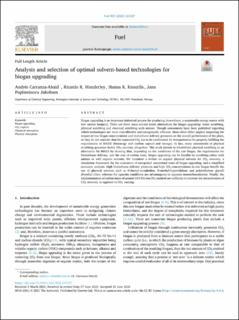| dc.contributor.author | Carranza Abaid, Andres | |
| dc.contributor.author | Ramos Wanderley, Ricardo | |
| dc.contributor.author | Knuutila, Hanna K | |
| dc.contributor.author | Jakobsen, Jana Poplsteinova | |
| dc.date.accessioned | 2021-08-11T06:05:13Z | |
| dc.date.available | 2021-08-11T06:05:13Z | |
| dc.date.created | 2021-07-01T19:14:46Z | |
| dc.date.issued | 2021 | |
| dc.identifier.issn | 0016-2361 | |
| dc.identifier.uri | https://hdl.handle.net/11250/2767254 | |
| dc.description.abstract | Biogas upgrading is an important industrial process for producing biomethane, a sustainable energy source with low carbon footprint. There are three main solvent-based alternatives for biogas upgrading: water scrubbing, physical scrubbing and chemical scrubbing with amines. Though assessments have been published regarding which technologies are more cost-effective and energetically efficient, these often either neglect inspecting the impact of raw biogas concentrations and biomethane delivery pressures on the overall performance of the plant, or they do not consider that the separated CO2 has to be conditioned for transportation for properly fulfilling the requirements of BECCS (bioenergy with carbon capture and storage). In fact, many assessments of physical scrubbing processes forfeit CO2 recovery altogether. This work intends to rehabilitate physical scrubbing as an alternative for BECCS by showing that, depending on the conditions of the raw biogas, the requirements for biomethane delivery, and the cost of carbon taxes, biogas upgrading can be feasible by scrubbing either with amines or with organic solvents. We introduce a review on organic physical solvents for CO2 recovery, a simulation framework for the evaluation of energetical operational costs of biogas upgrading, and a simplified economic analysis. High biomethane delivery pressures and high CO2 concentrations in raw biogas benefit the use of physical solvents such as N-formyl-morpholine, N-methyl-2-pyrrolidone and poly(ethylene glycol)dimethyl ether, whereas the opposite conditions are advantageous to aqueous monoethanolamine. Finally, the implementation of carbon taxes of around 10 USD/ton CO2 emitted are sufficient to increase the attractiveness of CO2 recovery as opposed to CO2 wasting. | en_US |
| dc.language.iso | eng | en_US |
| dc.publisher | Elsevier | en_US |
| dc.relation.uri | https://www.sciencedirect.com/science/article/pii/S0016236121012060#! | |
| dc.rights | Navngivelse 4.0 Internasjonal | * |
| dc.rights.uri | http://creativecommons.org/licenses/by/4.0/deed.no | * |
| dc.title | Analysis and selection of optimal solvent-based technologies for biogas upgrading | en_US |
| dc.type | Journal article | en_US |
| dc.type | Peer reviewed | en_US |
| dc.description.version | publishedVersion | en_US |
| dc.subject.nsi | VDP::Matematikk og naturvitenskap: 400 | en_US |
| dc.subject.nsi | VDP::Mathematics and natural scienses: 400 | en_US |
| dc.source.volume | 303 | en_US |
| dc.source.journal | Fuel | en_US |
| dc.identifier.doi | 10.1016/j.fuel.2021.121327 | |
| dc.identifier.cristin | 1919925 | |
| dc.relation.project | Norges teknisk-naturvitenskapelige universitet: 81771071 | en_US |
| cristin.ispublished | true | |
| cristin.fulltext | original | |
| cristin.qualitycode | 2 | |

